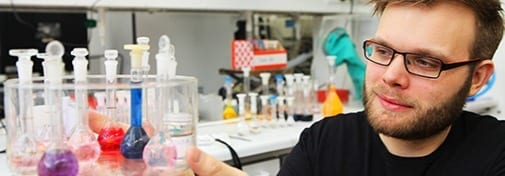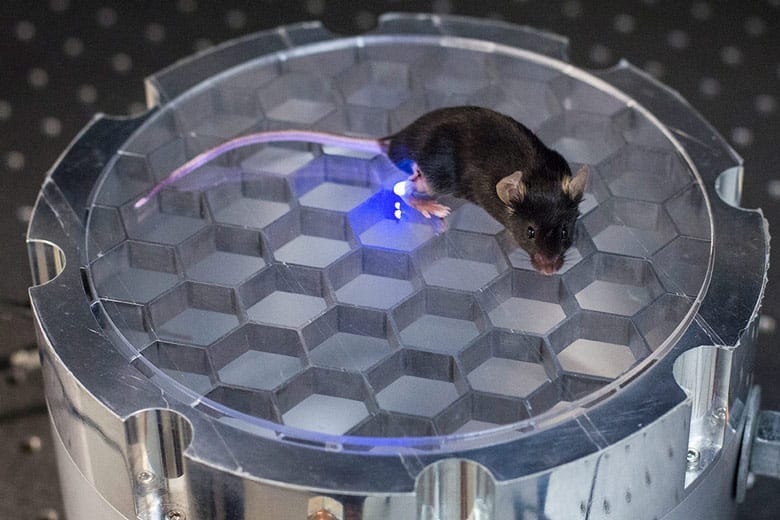
Thomas Just Sørensen, an associate professor at the University of Copenhagen, spearheaded the research project. The groups result has been published in the internationally recognized journal ChemNanoMat in an article entitled, “Template-Guided Ionic Self-Assembled Molecular Materials and Thin Films with Nanoscopic Order”. Sørensen believes that the result will spawn new breakthroughs:
When researchers dream about electronics of the future, they more or less dream of pouring liquids into a beaker, stirring them together and decanting a computer out onto the table. This field of research is known as self-assembling molecular electronics. But, getting chemical substances to self-assemble into electronic components is just as complicated as it sounds. Now, a group of researchers has published their breakthrough within the field.
The secret behind the breakthrough is… Soap.
The group consists of first-year nanoscience students from the University of Copenhagen.
“This is a clear step forward towards self-assembling electronics. By mixing solutions of the right substances, we automatically built structures that in principle could have been solar cells or transistors. What is more, is that they were built in the same way that nature builds such things as cell membranes,” says Sørensen.
First year students on authors list
Sørensens co-authors are the entire first-year of University of Copenhagen nanoscience students. This impressive feat is the result of a restructuring of the nanoscience programme in 2010, from a programme structured upon research-based instruction, to one that uses teaching-based research. For their first assignment, the students were simply asked to design, conduct and analyse a range of experiments. The new instructional type has shed research results every year since. However, it wasn’t until 2013 that a result was ready to be published.
“For us as a university, the big news is obviously that first year students conducted the research. But, we achieved a very significant result in molecular electronics as well,” states Thomas Just Sørensen.
Electronics development turned up-side down
Electronics are normally produced in such a way that one “draws” components onto a silicon wafer and then removes all the bits that are not part of the electronic component. This is called “Top-down” production. Molecular electronics enables the production of transistors, resistors, LED screens, solar cells and so on, using chemistry-based methods. In principle, this means that electronics can become smaller, cheaper and more flexible, as well as environmentally sustainable. But whereas one can draw an integrated circuit on silicon, molecular components must self-organise into the correct structures. This is a major obstacle in the development of methods where molecules must join and self-organise in such a way that they can be found again, according to Sørensen.
“It doesn’t help to have a pile of transistors, if you don’t know which way they are turned. These cannot be combined in a way to make them work, and one won’t know which end to connect to electric current.”
Cosmetics ingredient made self-assembly possible
The secret behind the breakthrough is… Soap. The molecular components that make self-assembling electronics possible are antifungal agents used in various disinfectants, creams and cosmetics. These cleansers kill fungi by disrupting the structures of their cell membranes. This same ability can be used to create order among molecular components. Sørensen and his students experimented by pouring a flood of various soaps, dish-soaps and washing powders together with component-like chemical substances. The mixtures were then poured out onto glass plates in order to investigate whether or not the “components” were organised by the various cleansing agents. And now they have been, says Sørensen.
“Our self-assembling electronics are a bit like putting cake layers, custard and frosting in a blender and having it all pop out of the blender as a perfectly formed layer cake,” says Thomas Just Sørensen.
Just one step away from front page news
In the long term, these new discoveries open the door to developing powerful and economical solar energy facilities, as well as improved screen technologies. That being said, the molecules used in the nanoscience programme had no electronic functionality. “If they did, we would have been on the cover of Science instead of in a ChemNanoMat article,” says Just Sørensen. Regardless, he remains confident.
Read more: Danish breakthrough brings futuristic electronics a step nearer
The Latest on: Self-assembling electronics
[google_news title=”” keyword=”Self-assembling electronics” num_posts=”10″ blurb_length=”0″ show_thumb=”left”]
via Google News
The Latest on: Self-assembling electronics
- New class of spongy materials can self-assemble into precisely controllable structureson April 30, 2024 at 8:02 am
A team of researchers led by the University of Massachusetts Amherst has drawn inspiration from a wide variety of natural geometric motifs—including those of 12-sided dice and potato chips—in order to ...
- Smartphone builder Xiaomi rolls 10,000 units of its flagship SU7 off assembly line in just 32 dayson April 29, 2024 at 10:05 am
Just over a month after launching its first-ever BEV, smartphone developer, Xiaomi is touting some big production numbers for ...
- Tata Electronics Building High-Tech Machinery to Manufacture iPhone Casing in India: Reporton April 26, 2024 at 2:54 am
Tata Electronics initiative is set to reduce Indias reliance on imports for such technology, which has predominantly been sourced from China until now.
- Tata Electronics to soon manufacture iPhone casings in Indiaon April 25, 2024 at 11:45 pm
Tata Group is close to securing a controlling interest in Pegatron's Indian iPhone manufacturing facilities. Bloomberg reported that the Tata Group may finalize a deal to take control of Pegatron's ...
- For years, manufacturing left the U.S. Now, it's begun to come home. Here are 5 things to know.on April 25, 2024 at 9:56 am
If a lack of skilled workers isn't resolved soon, by 2030 there’s going to be a labor shortage of 2 million in U.S. manufacturing.
- Research combines DNA origami and photolithography to move one step closer to molecular computerson April 24, 2024 at 8:49 am
Molecular computer components could represent a new IT revolution and help us create cheaper, faster, smaller, and more powerful computers. Yet researchers struggle to find ways to assemble them more ...
- Self-assembling synthetic cells act like living cells with extra abilitieson April 23, 2024 at 5:00 pm
For the new study, scientists from the University of North Carolina at Chapel Hill developed synthetic, self-assembling cytoskeletons, built out of DNA, peptides and other genetic material. “DNA does ...
- Supreme Court will take up 'ghost guns' case next termon April 22, 2024 at 12:55 am
The court will decide if "self-assemble" guns require a background check. The Supreme Court said Monday it would take up the issue of "ghost guns" next term and the Biden administration's appeal ...
- How 3D immersive reality training will help close the skilled labor gapon April 18, 2024 at 12:41 pm
Despite significant post-pandemic recovery, the U.S. is in the grips of a skilled labor shortage. Since the Great Resignation of 2021, companies have scrambled to recruit and onboard workers fast ...
- Perfect Storm: AI, Robots, Chip Shortages. Can Automakers Weather It?on April 16, 2024 at 5:10 pm
The once-unstoppable auto industry, a 20th-century titan synonymous with manufacturing disruption and progress, now finds itself caught in a perfect storm.
via Bing News










